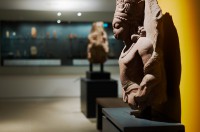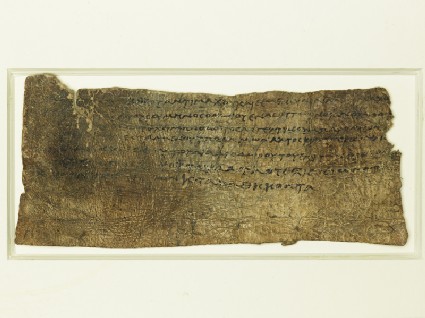Room 12 | India 2500 BC-AD 600 gallery
Explore the early development of Indian art, from the artefacts of the Indus Valley to the Hindu and Buddhist sculpture of north India and Gandhara.

Galleries : 116 objects
- Reference URL
Actions
Bactrian Greek tax receipt
-
Description
Inscribed on skin, the Greek text is a receipt for taxes. It is notable for mentioning the Greco-Bactrian king Antimachus (185-170 BC).
-
Details
- Associated place
-
Asia › Afghanistan (place of creation)
- Date
- c. 180 BC
- Associated people
-
King Antimachus I (ruled 185 BC - 170 BC) (named on object)
- Material and technique
- ink on skin
- Dimensions
- 6.1 x 14 cm approx., max. (height x width)
- Material index
- Technique index
- Object type index
- No. of items
- 1
- Credit line
- Presented by R. C. Senior, 1994.
- Accession no.
- EA1994.79
-
Further reading
Pantermalēs, Dēmētrios, Alexandros kai Anatole [=Alexander and the East] (Thessaloniki: Organismos Politistikes Proteuousas tes Europes, 1997), No. 141, 176-177
Rea, John, R. C. Senior, and A. S. Hollis, ‘A Tax Receipt from Hellenistic Bactria’, Zeitschrift für Papyrologie und Epigraphik, 104, (1994), passim, pl. 5
Bernard, Paul, and Claude Rapin, ‘Un parchemin gréco-bactrien d'une collection privée’, Comptes-rendus des séances de l'Académie des inscriptions et belles-lettres, 138/1, (1994), passim, illus. p. 262 fig. 1
Rea, J. R., R. C. Senior, and A. S. Hollis, ‘The Tax Receipt from Hellenistic Baktria’, summarized and trans. by M. J. A. Tzamali, Nomismatika Khronika, 16, (1998)
Location
-
- currently in research collection
Objects are sometimes moved to a different location. Our object location data is usually updated on a monthly basis. Contact the Jameel Study Centre if you are planning to visit the museum to see a particular object on display, or would like to arrange an appointment to see an object in our reserve collections.
Galleries
Notice
Objects may have since been removed or replaced from a gallery. Click into an individual object record to confirm whether or not an object is currently on display. Our object location data is usually updated on a monthly basis, so contact the Jameel Study Centre if you are planning to visit the museum to see a particular Eastern Art object.
© 2013 University of Oxford - Ashmolean Museum



